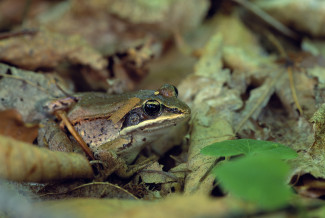
Johns Hopkins UniversityEst. 1876
America’s First Research University
The Beauty in your Own Back Yard - with Bryan MacKay

“An early morning walk is a blessing for the whole day” – Henry David Thoreau
Recalling the wise advice of the Sage of Concord, I head down a trail near my home on an unseasonably warm February morning. It has rained lightly during the night, and a humid fog settles in the low places. Although I usually set a goal of seeing some aspect of nature on these walks, today I have no such expectations; it is early in the calendar year, and the quiet season of winter still grips the Maryland countryside. Even so, after so many days of snow, ice, and cold, it’s good to get out and breathe fresh, clean air, and stir the blood so oxygen reaches every cell.
Thirty minutes of quietude is broken by an odd noise ahead; the sound of quacking ducks reaches my ear. But this is a forest, and I know there is no open water nearby. As I get closer, the sound gets louder, and I realize it’s not quite a quack, but something different. Dredging up memories of past hikes, I realize I’m hearing wood frogs.
And not just one or two wood frogs, but dozens, even hundreds, a convention of wood frogs, one of the mid-Atlantic’s earliest signs of spring. On warm, wet nights in late February or early March, warming soil temperatures bring wood frogs out of their winter estivation chambers, and they move downhill toward water, toward vernal ponds that are wet for only a few spring months. These ponds are often small, from a few feet to a few dozen feet in diameter, shallow, and bounded by woody debris. Males arrive first, and stake out sites where they can survey the pond, and where their songs can be best heard and appreciated by some passing female wood frog.
As I arrive at what seems to be the noisiest pool, the amphibian chorus grows silent. But as I sit quietly, the calls soon resume; the drive of surging hormones cannot be denied or ignored. And so I become a watcher at the pool, a sentient observer of these frogs at the most noticeable and notable moments of their otherwise anonymous existence.

There is much quarreling among the males as they jockey for position; chases occur, and physical battles are not uncommon. When a female arrives, chaos ensues: males swim toward her, grab her, mount her, and attempt to squeeze out the eggs from her swollen belly. It quickly becomes a scrum, with as many as a dozen males forming a seething mass of amphibian bodies, each individual intent on releasing sperm to fertilize the freshly-released gob of jelly-coated eggs.
Wood frogs are explosive, synchronous breeders; within a day or two of this conjugal event, they will all have dispersed back into the adjacent forest, where they are rarely noticed and are silent for another year. Just three days later, curious, I return to this same trail, this same vernal pool, and find only several tennis-ball-size masses of black eggs coated in clear jelly, and a single dead female, floating belly-up, killed by the enthusiastic attentions of all those males. It’s a poignant moment: death amid new life. The species has renewed itself, even at such great cost to an individual, and the chain of life goes on. Something to ruminate upon for the remainder of my hike, springtime’s earliest event, as the season begins its long slow turn toward reawakening and re-creation.
Bryan MacKay is a senior lecturer emeritus in the Department of Biological Sciences at the University of Maryland, Baltimore County. He is the author of Hike Maryland, Cycle Maryland and Paddle Maryland as well as A Year Across Maryland: A Week-by-Week Guide to Discovering Nature in the Chesapeake Region and Baltimore Trails: A Guide for Hikers and Mountain Bikers.


